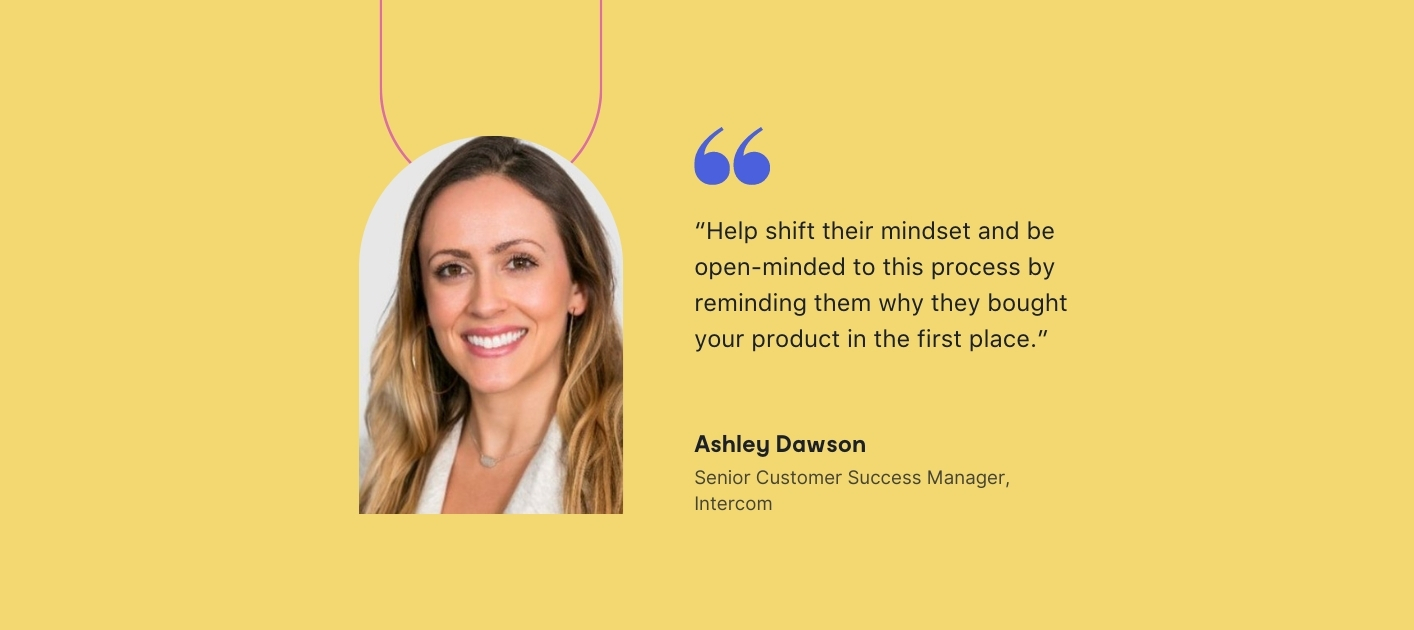Your support software helps your customers achieve a number of goals.
Perhaps to more easily track and respond to queries. Maybe to manage support from different channels. Or possibly to help boost sales.
In all probability, it’s some combination of everything above.
Whatever the case, this can only be made possible if you help your users to build a deeper relationship with the customers they serve.
This is why we spoke to the good folk at Intercom to find out the most successful tactics that they’ve used to ensure clients get the most out of their customer interactions.
And now we’re going to share them with you.
Let’s dive right in!

Have conversations where you don’t mention your product
When talking to clients, you’ll probably hear them say words or phrases that ring a bell. Ones closely tied to your product.
And the natural tendency is to immediately switch to ‘demo mode’. Speaking about how your product fits in.
But this is where you could benefit from stepping back and just listening to what exactly they’re trying to accomplish.
Your early conversations should be purely dedicated to learning about their needs and workflows.
You’ll want to understand the KPIs that’ll help make them successful (whether it’s CSAT, NPS, FRT, or something else) and give them a path to achieve them.
Taking time to analyze their customer service goals will help you come back to them with prescriptive recommendations best suited to their needs. Which will ultimately help them get the most out of their customer interactions.
Making time to talk about things outside of work will help you establish a connection on a human level, even if it’s just for 5 minutes before a meeting. This will result in customers bringing their guards down and being more open to giving feedback, talking to your product teams, etc.
Understand the customers your clients work with
This is closely tied to the previous point.
To help your clients maximize the quality of their support interactions, it’s not enough to have an understanding of them.
But you’ll need to take it a step further and also thoroughly understand everything about the customers they serve.
You’ll want to gain a clear picture of:
- how they like to communicate
- the channels they like to communicate on
- what kind of language they use

Have your clients take you through their product like you’re a new customer. And try and find your way around their product just like a new customer would. This will help you see first-hand where the gaps lie.
A thorough understanding of the different personas of the customers your clients work with will give you the basis for what you should recommend helping them achieve their goals.
Different demographics resonate with different strategies. So it’s vital you understand the different personas of customers your clients are dealing with.
Focus on improving the agent experience
An often overlooked fact when talking about improving customer interactions is the agent experience itself.
A complicated interface or workflow usually means the quality of responses won’t be as high as it could be.
So you’ll want to make sure your tool provides agents with:
- Sufficient context about customers
- Quick links to easily looking up information
- The ability to personalize and add their own touch to responses
- A way to efficiently automate repetitive tasks (with macros, canned responses, etc.)
The above is far from an exhaustive list of features that your tool needs.
But if you can ensure support agents enjoy using your software, this impact will carry over into the quality of customer interactions they have.
Improving the agent experience means helping them be more efficient and focus on the most important tasks. For example, completely automating repetitive queries can help agents save time and focus on more important tasks while also ensuring customers receive instant responses.
Make the transition to using your product smooth
Transitioning to a new product with a different interface, channels, metrics, and reports can be intimidating.
And that’s something you’ll need to be mindful of.
During your early conversations with clients, telling them everything about your product, its features and all that it can do may not be the ideal approach.
In fact, this can often paralyze clients due to the sheer amount of information.
A better way to go about it is by showing them how the most successful companies in their space use your product. Putting things in a relevant and relatable perspective will give them the context to make the most out of your product.

Whenever you’re facing resistance, bringing it back to the ‘pain’ they’re trying to solve can help make sure your clients keep an open mind. Which in turn will help them get over the early learning curve a lot quicker.
While you want to be on hand to help customers come to grips with your product, you’ll also want to have useful self-serve content (articles, demo videos) that they can refer to and digest at their own pace.
Be transparent about what your product can and can’t do
Your product cannot do everything for everyone.
There will always be areas where you’re not best positioned to help a client.
And as long as you’re upfront about what your product can and cannot do, that’s completely fine.
Several tools will do a great job of complementing the workflows of your product. And if anything it’ll strengthen what customers can do with your product.
You’ll also find that customers will often struggle to articulate what exactly they need. So you’ll need to do a lot of discovery to understand what exactly they’re trying to accomplish before recommending a third-party solution.
You probably don’t know each and every third-party solution in your app store. But you do know they’ve gone through a vetting process to be there. And sometimes the easiest way to find the best solution for your customer is by going through different apps together, signing up for free trials, and finding the one that works best.
Create a space for your customers to talk to each other
Your customers are constantly going to be looking for ways to improve the quality of their support.
And they may not always want to come to you for these answers.
This is why it makes sense to create a space where your customers can directly interact and bounce ideas off each other.
Getting insight from how people just like them overcame problems or found solutions gives your customers a different and relatable perspective.
Doing this could be something as simple as creating a Slack channel compromised of similar groups of customers. Where your only role would be to facilitate conversations amongst themselves.

You can do this by talking about very specific issues relevant to your customers which will serve as the catalyst for conversation. This could be in the form of product updates, informative blog posts, videos, or anything else that could be useful to them.
You can create a space for customers to talk to each other by simply connecting them on the channel they prefer (Slack, Whatsapp, Telegram, etc.) or you could try something like we’ve done with the Quality Tribe.
Involve your non-customer-facing teams in conversations
You want to add value to your customers in a way that you almost function like an extension of their team.
And to do this you’ll need to sometimes go out of your way to make your customers successful.
Leveraging your own experience as a support organization is a great way to help your customers overcome their problems.
For example, let’s suppose you’re talking to a customer struggling to maintain consistency within their support team.
You could bring in someone from your own Support Ops team to take them through how you go about doing QA at your organization, the tools you use for it, etc.
You want to pull all the resources you have at your disposal to help your customers.
So don’t shy away from including members from different departments of your organization if you think clients could benefit from having these conversations.
Applying all the knowledge you have and bringing that to your customers in a personalized way will ensure that your customers can improve the quality of the service they provide.
Most of your customers won’t outright ask to speak to different members of your organization. But you should proactively let them know that they have the option to if they ever feel the need to.
Back up the feedback you gather with real action
Encouraging a culture of feedback in your organization is a great way to build trust and empathy with your customers.
But if you’re listening all day and there’s no real action, there’s no real value for the customer.
This is why you need to show customers you’re listening – with your product.

And for this, you’ll need to have an efficient way of articulating feedback internally and projecting the voice of your customer.
Now, of course, it’s not always possible to reflect everything that a customer requests into your product.
But you can still show them that they’re being heard. For example, you could do this by having one of your Product Managers directly explain why a certain feature isn’t being built.
As long as you show that feedback and the time spent giving it goes into good use, your customers will be happy to continue giving it.
Having a public product board where customers can see your roadmap while also being able to vote on features they’d most like to see is one good way to collect feedback and show that you’re acting upon it.
So there you have it!
8 super actionable tactics you can implement to help your clients make the most out of their customer interactions.
It goes without saying these aren’t one-and-done fixes. But rather processes that need to be integrated into your systems.
But if you implement them consistently you’ll start seeing your clients get the most out of your tool and their customer interactions. Win-win!
We want to give a huge shoutout to Aron, Ashley, Christina, and Hannah from Intercom who were super generous with their time. And without whom this blog post would have been impossible.
We’re really proud to be Intercom’s Premier App Partner and help customer-facing teams improve the quality of their interactions through systematic QA and conversation review processes.
Want to ask something to our interviewees or have something to add? Join our online CX quality community Quality Tribe and let’s discuss. Cat-ch you there my friend!
Read more ✨
17 Ways Intercom Builds Customer Relationships that Last
How These 5 Customer-Focused Companies Build Meaningful Relationships with Customers


